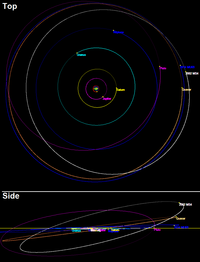(307261) 2002 MS4
| (307261) 2002 MS4 | |
|---|---|

| |
| Número | 307261 |
| Data da descoberta | 18 de junho de 2002[1] |
| Descoberto por | Chad Trujillo, Michael E. Brown[1] |
| Categoria | Transnetuniano (cubewano)[2] |
| Elementos orbitais[3] | |
| Semieixo maior | 41,676 UA |
| Periélio | 35,612 UA |
| Afélio | 47,741 UA |
| Orbita | Sol |
| Excentricidade | 0,146 |
| Período orbital | 98 630 dias |
| Anomalia média | 210,108°° |
| Inclinação | 17,7° |
| Longitude do nó ascendente | 216,086°° |
| Argumento do periastro | 213,200°° |
| Características físicas | |
| Dimensões | 800 ± 24 km[4] km |
| Classe espectral | B-V=0,69; V-R=0,38[5] |
| Magnitude aparente | 20,6[6] |
| Magnitude absoluta | 3,7[3] |
| Albedo | 0,084+0,03 −0,02[7] |
| ver | |
(307261) 2002 MS4 é um objeto transnetuniano localizado no cinturão de Kuiper, uma região do Sistema Solar. Este objeto é classificado como um cubewano.[2] Ele possui uma magnitude absoluta de 3,7.[8][3] Em 2007 o telescópio espacial Spitzer estimou um diâmetro de 726 ± 123 quilômetros.[7] Em 2012 o Observatório Espacial Herschel estimou um diâmetro maior de 800 ± 24 quilômetros.[9] Devido ao seu tamanho relativamente grande, o mesmo é considerado um forte candidato a ser classificado como planeta anão.[10]
Com 800 quilômetros de diâmetro, está aproximadamente empatado com (55565) 2002 AW197 e (532037) 2013 FY27 (dentro das incertezas de medição) como o maior objeto sem nome no Sistema Solar.
Descoberta
[editar | editar código-fonte](307261) 2002 MS4 foi descoberto no dia 18 de junho de 2002[1] pelos astrônomos Chad Trujillo e Michael E. Brown.[1][8]
Órbita
[editar | editar código-fonte]A órbita de (307261) 2002 MS4 tem uma excentricidade de 0,146 e possui um semieixo maior de 41,676 UA. O seu periélio leva o mesmo a uma distância de 35,612 UA em relação ao Sol e seu afélio a 47,741 UA.[8] Está atualmente a 47,1 UA do Sol.[6]
Referências
- ↑ a b c d «MPEC 2002-W27 : 2002 MS4, 2002 QX47, 2002 VR128». IAU Minor Planet Center. 21 de novembro de 2002. Consultado em 26 de agosto de 2009
- ↑ a b «MPEC 2009-P26 :Distant Minor Planets (2009 AUG. 17.0 TT)». IAU Minor Planet Center. 7 de agosto de 2009. Consultado em 31 de agosto de 2009
- ↑ a b c «JPL Small-Body Database Browser: (2002 MS4)». JPL. Consultado em 24 de agosto de 2009
- ↑ Rommel, Flavia L.; Braga-Ribas, Felipe; Vara-Lubiano, Mónica; Ortiz, Jose L.; Desmars, Josselin; Morgado, Bruno E.; et al. (setembro de 2021). Evidence of topographic features on (307261) 2002 MS4 surface. 15th Europlanet Science Congress 2021. Europlanet Society. Bibcode:2021EPSC...15..440R. doi:10.5194/epsc2021-440. EPSC2021-440. Consultado em 13 de setembro de 2021
- ↑ Tegler, Stephen C. (26 de janeiro de 2006). «Kuiper Belt Object Magnitudes and Surface Colors». Consultado em 5 de novembro de 2006. Arquivado do original em 1 de setembro de 2006
- ↑ a b «AstDyS 2002MS4 Ephemerides». Department of Mathematics, University of Pisa, Italy. Consultado em 6 de dezembro de 2011
- ↑ a b Stansberry, Grundy, Brown, Spencer, Trilling, Cruikshank, Luc Margot Physical Properties of Kuiper Belt and Centaur Objects: Constraints from Spitzer Space Telescope (2007) Preprint arXiv
- ↑ a b c «List Of Transneptunian Objects» (em inglês). Minor Planet Center. Consultado em 9 de junho de 2015
- ↑ Vilenius, E., Kiss, C., Mommert, M.; et al. (abril de 2012). «"TNOs are Cool": A survey of the trans-Neptunian region VI. Herschel/PACS observations and thermal modeling of 19 classical Kuiper belt objects» (PDF). Consultado em 7 de maio de 2012
- ↑ Mike Brown. «How many dwarf planets are there in the outer solar system?». Consultado em 6 de dezembro de 2011
Ligações externas
[editar | editar código-fonte]- «Simulação orbital» (em inglês)
- «Imagens precovery de 2002 MS4» (em inglês)
Text is available under the CC BY-SA 4.0 license; additional terms may apply.
Images, videos and audio are available under their respective licenses.
